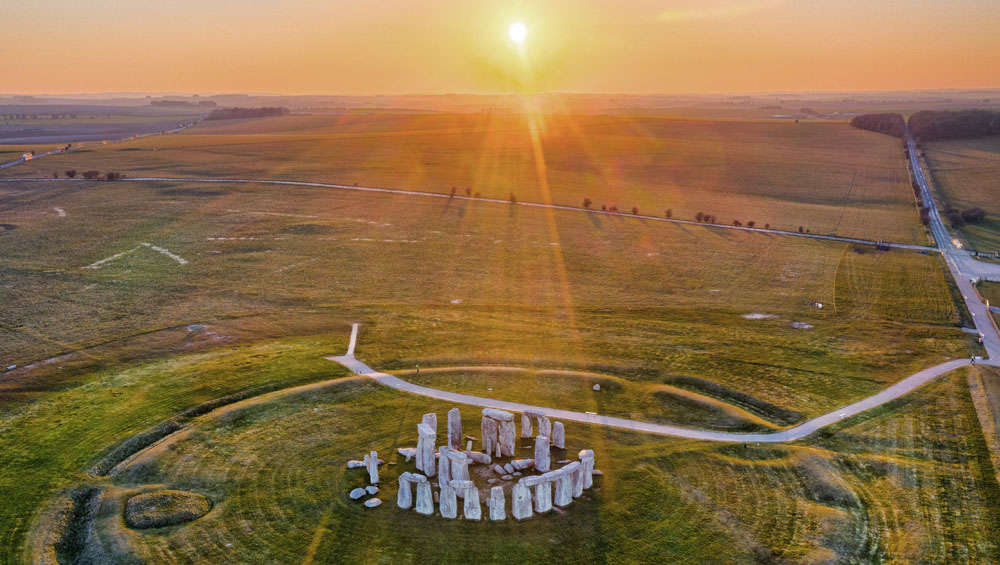Create a free profile to get unlimited access to exclusive videos, sweepstakes, and more!
Road work planned near Stonehenge might have to wait - mysterious bones and objects have emerged

There’s a reason you don’t start road work on a landmark archaeological site without having actual archaeologists check it out first, because the skeletons might have things to say.
Graves and artifacts more than 4,500 years old surfaced after a team of archaeologists surveyed a site near Stonehenge where the controversial A303 road tunnel was being planned. Some of the objects could have been used by the people who built Stonehenge. Whether the bones buried there really are the remains of those who built it remains a mystery. If proof of these builders is unearthed with any skeletons — before anyone even thinks about road work — they could speak from beyond the grave to tell us how they did it.
Anyone buried at Stonehenge could have been involved in its construction. Bones from several different time periods could qualify since the henge was built in phases. There is no particular way to identify one of the builders, so there is a chance that any human remains found in the area could have belonged to one of them. A303 Stonehenge archaeologist Matt Leivers of Wessex Archaeology, which is collaborating with Highways England for thorough exploration of what may become the tunnel, believes there are certain things that can at least indicate who might have been there thousands of years ago.
“There is no technique that can ‘fingerprint’ individual people as the builders of Stonehenge,” Leivers told SYFY WIRE. “What we can do is take all of the various strands of evidence that we have available to us, such as cultural affiliation, proximity and scientific dating, and build up a picture of likelihoods. If we can radiocarbon date one of the burials we found to the same time as the building of one of the phases of Stonehenge, then we can suggest that that person was there at the time, and may well have been involved."
What Leivers and his team found goes beyond bones. The graves themselves are the same age as the bluestones in the henge, as opposed to the larger sandstone sarsens, which could tell us more about that phase of building. Here is where it gets more confusing. More new research has found that the bluestones, which are already known to have come all the way from Wales, were part of a similar structure there that probably had the same type of cultural and religious significance. There was even evidence. A fragment of bluestone thought to be from one of the pillars was found at the bottom of a ditch where that pillar is believed to have stood.
Why the birthplace of the immortal bluestones was abandoned is unclear. What scientists involved in that investigation could tell was that the people obviously took their beliefs with them. Stone was seen as belonging to the realm of the dead because it is (almost) everlasting. If Stonehenge belonged to those who had passed, the nearby site known as Woodhenge was for the living. Not that you actually had to be a ghost to cross over to Stonehenge. The summer and winter solstice were always celebrated there, and other artifacts that were recently found are giving archaeologists like Leivers a clearer idea of what the lives of the people who built and used it were like.
“The most intriguing find is doubtlessly a shale object from one of the graves, precisely because we have no idea at all what it was,” Leivers said. “The individual things themselves aren’t really what are most interesting, it’s the picture they build up of what people were doing and what life was like at the various points in time that they were living and dying around Stonehenge.”
While it could have been the tip of a ceremonial staff or mace made of wood that eventually rotted, there is no real evidence for what the cylindrical piece of shale was actually used for. Nothing like it had ever previously been found. Other artifacts that surfaced include red deer antlers as ancient as the henge itself and pottery, especially mugs or “beakers” that were made by the Bronze Age people now called the Beakers because they buried their dead with this kind of pottery. The two graves in which these pots or mugs were found were of a small child and a young woman with whom the strange piece of shale was buried with.
Another mystery at the A303 site was a pattern of ditches with pieces of burnt flint that indicate something involving fire was going on there, possibly leatherworking.
“There are a number of possible activities that the burnt flint could derive from, but until we’ve excavated the rest of the enclosure we won’t know for sure,” Leivers said. My guess at the moment is that it’s some smelly or dirty industrial process that people didn’t want taking place among their houses.”
The A303 tunnel, which, despite how intrusive it could be, is meant to move traffic underground so it doesn’t distract from the otherworldly view of Stonehenge, is supposed to start construction in 2023. It may still experience delays. No road work will proceed until the entire site has been scoured for artifacts. Leivers will make sure of that.
“No-one is going to bulldoze any priceless archaeology,” he said. “Everything will have been excavated and recorded before construction of the road starts.”



























